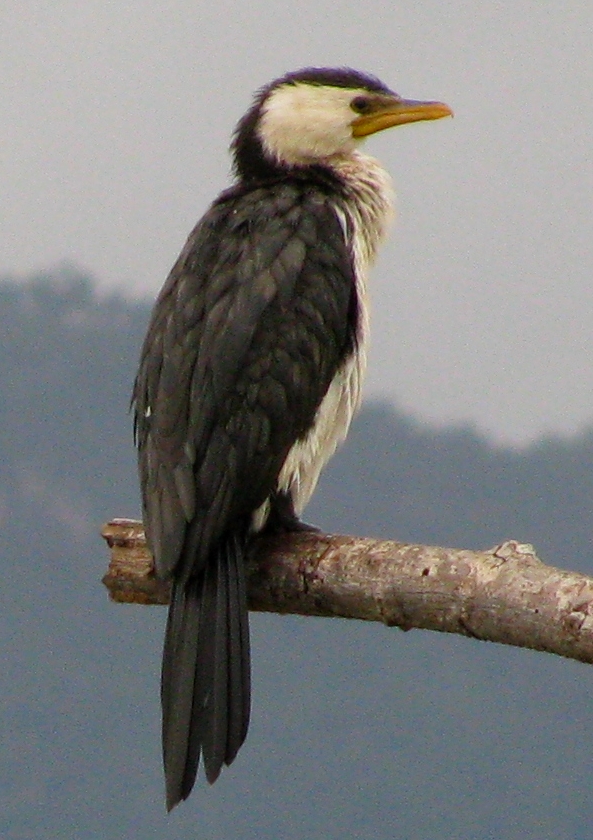
Little Pied Cormorant, Bicentennial Park, Townsville, Queensland, in the Rain (© Magi Nams)
Rain poured, fell steadily, or drizzled from brooding cloud onto Townsville today, necessitating the use of my umbrella while I walked the Ross River Parkway this morning and late afternoon. Water lay along curbs, and road-washed gum leaves were stranded in crooked piles like beach debris washed onto a bitumen shore. Handsome rainbow lorikeets looked surprisingly bedraggled, their vivid neck feathers clumped in wet bunches. Australian white ibises, my avian sheep, foraged in flocks on sodden lawns patrolled by a squadron of diving and banking welcome swallows. Beside the river, a helmeted friarbird and little pied cormorant perched on a dead tree, the cormorant’s feathers damp and scruffy, and those of the friarbird puffed out like a chickadee’s during a Canadian winter cold snap. Grey cotton clouds hung low on the slopes of Mount Stuart, promising more precipitation.
Perhaps this rain is a forerunner of the forecast early Wet I wrote about two weeks ago. Townsville has had an unusually damp spring so far this year, the frequent precipitation greening pastures and mountain slopes, maintaining lawns and holding at bay the brown dustiness typical of this dry tropics landscape during the lead-up to the onset of the summer Wet. On our arrival in Townsville on December 30, Vilis and I were shocked at the dessicated appearance of the savannah surrounding the city and on Castle Hill and Mount Stuart, the grasses grey and deadened, the tree leaves limp and dusty. ‘Brownsville’ is a dry-season nickname for Townsville, and it certainly fit then. But not now. The city I saw on my wet outings today bears no resemblance whatsoever to that bleak landscape beaten into submission by the sun.
So, why all the rain? Queensland has received above-average rainfall during much of the year due to the presence of an entrenched La Niña system offshore.1 Above-normal ocean surface temperatures in the Coral Sea and along the top of the continent, in conjunction with below-average ocean surface temperatures in the central and east Pacific Ocean, encourage evaporation in Queensland’s offshore waters, leading to a buildup of waterlogged air.1 Strong trade winds push the moisture-laden air onto shore, resulting in rain – lots of rain.1 Wild storms in September dumped record-breaking rainfalls – up to 100 millimetres or more over short time periods – on towns and cities along the Queensland coast.1 During October, violent storms have lashed southeastern Queensland, and Townsville has received twice as much rain to date as the city’s longterm October average precipitation.2 So, she’s definitely a wet one.
As I walked toward home, I watched an osprey winging above the river, pausing periodically to brake and take aim, then plunge in a dive to the water’s surface. Unlike me, with my umbrella and drizzle-spotted binoculars, it seemed completely unconcerned with the rain.
Today’s birds: pied imperial-pigeon, rainbow bee-eaters, mynas, white-gaped honeyeater, Australian white ibises, magpie-larks, brown honeyeaters, peaceful doves, rock doves, great bowerbird, rainbow lorikeets, bush stone-curlews, blue-winged kookaburra, mistletoebird, pheasant coucal, nutmeg mannikins, Pacific black ducks, Australian pelican, little pied cormorant, helmeted friarbird, yellow honeyeaters, masked lapwings, welcome swallows, black kite, house sparrow, osprey, leaden flycatcher, crested pigeon, white-breasted woodswallow, yellow-throated miners.
References:
1. Townsville Bulletin. 59.4 mm in 24 hours. September 21, 2010. The North Queensland Newspaper Company Pty Ltd © January 2007. Accessed 23-Oct-2010. http://www.townsvillebulletin.com.au/article/2010/09/21/171781_news.html
2. Weatherzone. Townsville Ap Daily Summaries. © Weatherzone 2010. Accessed 23-Oct-2010. http://www.weatherzone.com.au/station.jsp?lt=site&lc=32040&list=ds



Sounds like you are in birding heaven.
I am! The Townsville area (and all of Australia) has a wonderful variety of birds, many of them brightly coloured. The parrots and their relatives are exquisite, as are the rainbow bee-eaters. Some days, though, I long for blue jays and chickadees!